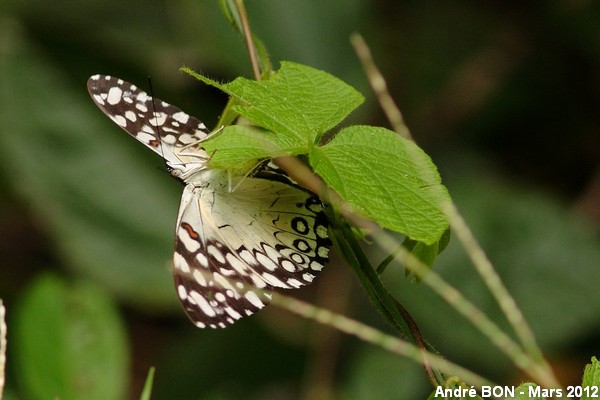
| Variable Cracker (Hamadryas feronia (Linnaeus, 1758)) |

|
|
Scientific name: Hamadryas feronia (Linnaeus, 1758) Common name: Variable Cracker French name: Craqueur variable Order: Lepidoptera Suborder: Rhopalocera Family: Nymphalidae Subfamily: Biblidinae Wingspan: 73 to 83 mm. Biotope: Road sides and woodland edges in tropical forests. Geographic area: Southern Texas, Central America, South America south to Brazil, Peru, Bolivia and Paraguay. Flight time: All year round, from July to December in the northern part of the range. Number of generations : Caterpillar: Bluish black with white dots, one lateral red stripe and many short and ramified spines. These spines are black except those on the middle segments which are yellow. Those on segments 3 and 10 are longer. Host plant: Euphorbiaceae of the Dalechampia genus , Dalechampia scandens, Dalechampia stenosepala, Dalechampia tiliifolia and Dalechampia triphylla. |
The upper side of the Variable Cracker's wings is marbled with beige, blue and white. The fore wings show a S-shaped red mark on the costal edge, at about one third of the costal edge length starting from the base. You can see this mark on both sides of the wings. The under side of the wings is a creamy white colour, marbled with dark brown on the fore wings, except in the basal area. The under side of the hind wings only shows a submarginal row of dark brown circles with a creamy white centre and one interrupted marginal band of creamy white and dark brown. The Hamadryas genus includes 20 species which are commonly called Crackers. This Cracker name comes from the sound emitted by males at take off. Crackers are often observed perched high on tree trunks, head down. Two other species of this genus also show one single red S-shaped mark at one third of the costal edge on the fore wings. You can tell the Grey Cracker (Hamadryas februa) apart by the presence of red crescents in the ocelli on the submarginal area of the hind wings. The Guatemalan Cracker (Hamadryas guatemalena), which is found in a reduced range from Guatemala to southern Texas, is more difficult to tell apart. You can use the inner size of the ocelli on the submarginal area of upper side of the hind wings. It is a constant size on Hamadryas guatemalena while it decreases from the costal edge on Hamadryas feronia. |
| [To know more about the Variable Cracker] [Top] |

|
I have shot this picture at Awala Yalimapo, les Hattes, while walking on a footpath going southwards from the D22 road. The red mark on the costal edge and the ocelli on the hind wings are enough to tell the species apart. I have also seen the upper side of the wings, but distracted by another butterfly in flight, I have not been fast enough to take the picture. He who hunts two |